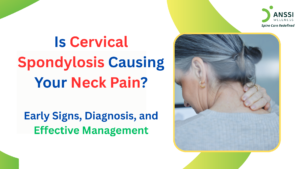Feeling dizzy or off balance can be disorienting, especially when it becomes a regular occurrence. For many people, the cause is often misdiagnosed as an inner ear or brain issue.
However, there’s a lesser-known condition called cervical vertigo; a form of dizziness that originates from the neck. Often overlooked or misunderstood, cervical vertigo can impact daily life but is highly manageable with the right care.
Let’s explore what cervical vertigo is, its symptoms, how it differs from other forms of vertigo, and the non-surgical treatment options available for it.
What Is Cervical Vertigo?
Cervical vertigo, also known as cervicogenic dizziness, is a condition where dizziness or unsteadiness arises due to issues in the cervical spine (neck region).
The neck plays a vital role in maintaining balance by providing sensory input to the brain through muscles, joints, and nerves. When these structures are compromised, whether by injury, inflammation, or degeneration, they can send distorted signals that affect balance and spatial orientation.
This condition is frequently associated with cervical spine disorders such as degenerative disc disease, herniated discs, or whiplash injuries. Since symptoms often overlap with other types of vertigo, it can be challenging to identify without a proper assessment.
Common Symptoms of Cervical Vertigo
Cervical vertigo presents with a mix of neurological and musculoskeletal symptoms, often triggered or worsened by head or neck movement.
Common signs include:
- A spinning sensation or dizziness, especially when turning the head
- Neck pain, stiffness, or tightness
- A feeling of imbalance or lightheadedness
- Headaches that may originate from the neck to the head
- Blurred vision or difficulty focusing, particularly during head movement
- Increased dizziness when maintaining certain neck postures (e.g., looking down at a phone)
These symptoms can be mild or severe and are often aggravated by poor posture, prolonged screen use, or physical strain on the neck.
Causes and Risk Factors
Cervical vertigo typically stems from mechanical or neurological dysfunction in the neck.
Key causes include:
Degenerative Disc Disease
Wear and tear in the cervical spine can affect the discs, leading to reduced disc height, inflammation, and nerve irritation; all of which can disrupt balance-related signals.
Herniated Cervical Discs
A herniated disc in the neck can press on nerves or restrict blood flow to the brain, contributing to vertigo-like symptoms.
Whiplash or Neck Trauma
Sudden impacts, such as in car accidents, can damage neck structures and lead to long-term cervical instability and dizziness.
Poor Posture or Tech Neck
Sustained forward head posture, from phone or computer work, strains the neck, potentially leading to muscle fatigue, joint dysfunction, and vertigo.
Other risk factors include cervical spondylosis (arthritis of the neck), muscle spasms, and limited neck mobility.
How Cervical Vertigo Differs from Other Types of Vertigo
Cervical vertigo is often confused with inner ear-related vertigo like Benign Paroxysmal Positional Vertigo (BPPV) or Meniere’s disease.
However, it has distinct differences.
Cervical Vertigo:
- Triggered by neck movement
- Associated with neck pain/stiffness
- No spinning sensation when the head is still
- Often improves with posture correction
BPPV / Meniere’s Disease:
- Triggered by head position or ear issues
- Often involves ear ringing or hearing loss
- Dizziness can occur even without movement
- Treated with vestibular therapy or medications
Proper diagnosis involves ruling out other causes of dizziness through imaging, vestibular testing, and clinical evaluation.
Non-Surgical Treatment Options
Cervical vertigo responds well to conservative, non-invasive treatments that address the root causes; mechanical dysfunction, inflammation, and nerve irritation.
1. Physical Therapy and Posture Correction
Targeted physical therapy strengthens neck muscles, improves posture, and enhances mobility. This reduces strain on spinal joints and nerves, easing vertigo symptoms.
2. Vestibular Rehabilitation
A specialised form of therapy focused on retraining the balance system. It combines eye, head, and body movements to stabilise vision and improve coordination.
3. Pain Management
In some cases, anti-inflammatory medications or muscle relaxants may be recommended to relieve acute symptoms. However, long-term use should be avoided without medical guidance.
4. Non-Surgical Spinal Decompression Treatment
When cervical vertigo is linked to herniated discs or degenerative disc disease, non-surgical spinal decompression treatment can be highly effective. This treatment uses a specialised decompression table to gently stretch the cervical spine, creating negative pressure that:
- Reduces disc bulge or herniation
- Improves circulation to spinal structures
- Relieves pressure on nerves and promotes healing
Non-surgical treatments offer safe, drug-free, and surgery-free relief from cervical disc-related vertigo, allowing patients to regain comfort, clarity, and balance without invasive procedures.
About ANSSI:
ANSSI Wellness focuses on improving the quality of life for patients suffering from spinal issues, aiming to provide relief where other conventional treatments have failed. Through advanced non-surgical spinal decompression treatment, ANSSI is committed to helping patients avoid surgery and recover in a safe, effective, and compassionate environment.
Connect with ANSSI Wellness on LinkedIn, Instagram, and Facebook for expert guidance.



